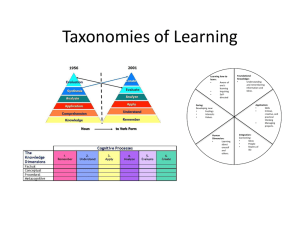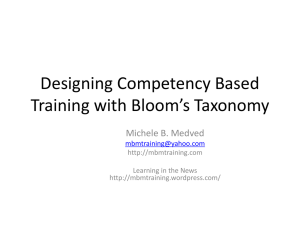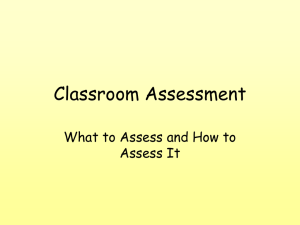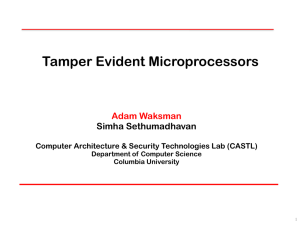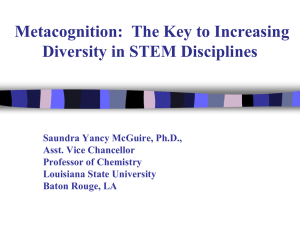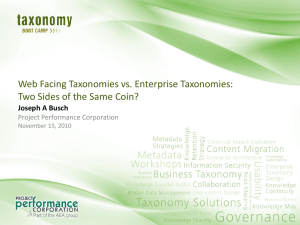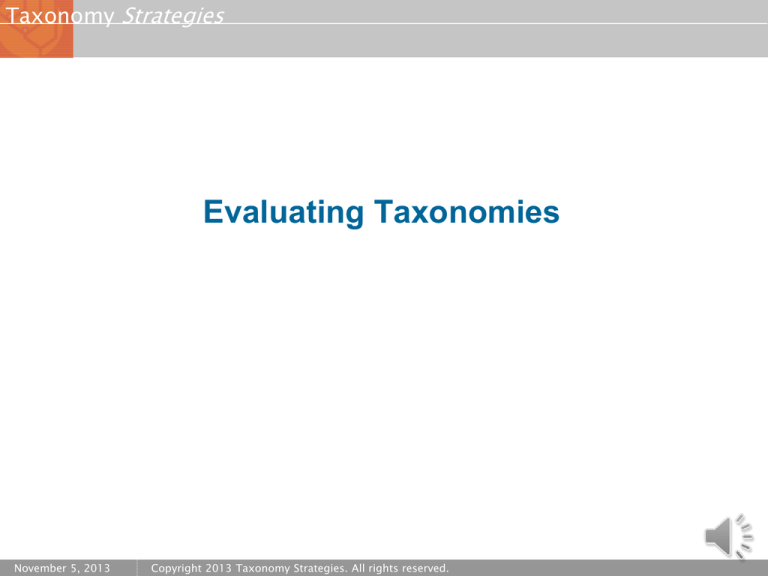
Taxonomy Strategies
Evaluating Taxonomies
November 5, 2013
Copyright 2013 Taxonomy Strategies. All rights reserved.
Agenda
Evaluation overview
Editorial evaluation
Collection analysis
Market analysis
Summary and questions
Taxonomy Strategies The business of organized information
2
Framework for evaluating taxonomies: How will the
taxonomies be used?
Use cases
Data management, Data warehouse, MDM, Big data
Business intelligence, Text analytics
eCommerce
Search and browse, Web publishing
Case studies
Healthcare.gov – findable web content, transaction help, customer
service
Energy companies – technical training, operational documentation, EHS
Retail and eCommerce – POS, labels, dynamic web content, ecommerce
Financial services organizations – AML, SAR, trading, analysis
Taxonomy Strategies The business of organized information
3
Editorial evaluation
Depth and breadth
Comprehensiveness
Currency
Relationships
Polyhierarchy (is it applied appropriately)
Naming conventions.
Taxonomy Strategies The business of organized information
4
Depth and breadth
Category List
Facet
Alternative Dispute Resolution
(ADR)
Topic
Antitrust
Topic
Attorneys
Role
Auditors
Role
Bankruptcy
Topic
Blue Sky Laws
Law
Canada
Location
Comprehensive Environmental
Response, Compensation and
Liability Act of 1980 (CERCLA)
Law
Czech Republic
Location
Employee Retirement Income
Security Act of 1974 (ERISA)
Law
European Union
Location
Law
Blue Sky
Laws
CERCLA
ERISA
…
Location
Canada
Czech
Republic
European
Union
…
Role
Attorneys
Auditors
…
Topic
ADR
Antitrust
Bankruptcy
…
Location
Africa
Asia
China
Europe
Latin America
Middle East
North America
Canada
Mexico
United States
…
Taxonomy Strategies The business of organized information
5
Taxonomy relationships
CONTENT ITEM
• UID / format / filename
• Author / title
• Description
• Dates
• Source
• Citation
Is
About
Legal Topic
And/or
Professional Topic
Is A
Content Type
And/or
Is A
Column
And/or
Is Part Of
Collection
Activity
Is Written
For
Organization
And/or
Is Result Of
Is Written
For
Law & Case
Geo-Political
And/or
Segment
Time Period
And/or
Audience
Is Published Via
Committee
And/or
Channel
Taxonomy Strategies The business of organized information
Other Keywords
6
Taxonomy relationships
CONCEPT
prefLabel
lc:sh85052028
Fringe
parking
altLabel
altLabel
altLabel
altLabel
Park
& ride
Park
and
ride
Parkn- ride
Park and
ride
systems
prefLabel
altLabel
trt:Brddf
Subject
Predicate
Object
lc:sh85052028
skos:prefLabel
Fringe parking
lc:sh85052028
skos:altLabel
Park and ride systems
lc:sh85052028
skos:altLabel
Park and ride
lc:sh85052028
skos:altLabel
Park & ride
lc:sh85052028
skos:altLabel
Park-n-ride
trt:Brddf
skos:prefLabel
Fringe parking
trt:Brddf
skos:altLabel
Park and ride
Taxonomy Strategies The business of organized information
CONCEPT
7
Naming conventions
1.
2.
3.
4.
5.
6.
7.
Label length
Nomenclature
Capitalization
Ampersands
Abbreviations & Acronyms
Languages
Special characters
Taxonomy Strategies The business of organized information
8.
9.
10.
11.
12.
13.
Serial commas
Spaces
Synonyms
Term order
Term ordering
Compound term labels
8
Collection analysis
Category usage analytics (is distribution of categories appropriate)
Completeness and consistency
Query log/content usage analysis
Taxonomy Strategies The business of organized information
9
Category usage analytics: How evenly
does it divide the content?
Documents do not distribute uniformly across categories
Zipf (long tail) distribution is expected behavior
80/20 Pareto rule in action
Leading candidate
for splitting
Leading candidates
for merging
Taxonomy Strategies The business of organized information
10
Category usage analysis: How does
taxonomy “shape” match that of content?
Term Group
% Terms
% Docs
Administrators
7.8
15.8
Community Groups
2.8
1.8
Counselors
3.4
1.4
Federal Funds Recipients
and Applicants
9.5
34.4
Librarians
2.8
1.1
News Media
0.6
3.1
Other
7.3
2.0
Parents and Families
2.8
6.0
Policymakers
4.5
11.5
Researchers
2.2
3.6
School Support Staff
2.2
0.2
Student Financial Aid
Providers
1.7
0.7
Students
27.4
7.0
Teachers
25.1
11.4
Taxonomy Strategies The business of organized information
Background:
Hierarchical taxonomies allow
comparison of “fit” between content
and taxonomy areas.
Methodology:
25,380 resources tagged with
taxonomy of 179 terms. (Avg. of 2
terms per resource)
Counts of terms and documents
summed within taxonomy
hierarchy.
Results:
Roughly Zipf distributed (top 20
terms: 79%; top 30 terms: 87%)
Mismatches between term% and
document% are flagged in red.
Source: Courtesy Keith Stubbs, US. Dept. of Ed.
11
Completeness and consistency: Indexer consistency
Studies have consistently shown that levels of consistency vary, and
that high levels of consistency are rare for:
Indexing
Choosing keywords
Prioritizing index terms
Choosing search terms
30%
Assessing relevance
Choosing hypertext links
Semantic tools and automated processes can help guide users to be
more consistent.
80%
Taxonomy Strategies The business of organized information
12
Query log analysis: Description of analysis process
Identify top query strings over annual period, average number of
words per query and distribution of queries – Are there a few that
make up the majority of the total number of queries?
Review each query string to determine what the user is trying to find.
Assign a concept/entity.
Each concept/entity is a type of thing. Review each and identify the
type or types of things.
Identify the top concepts/entities.
Perform analysis on internal and external queries as appropriate.
Taxonomy Strategies The business of organized information
13
Query log analysis: Internal Queries
Words typed into search box on healthcare.gov Aug 2011-July 2012
84,277 Total Queries in Sample
214 Total Unique Queries in Sample
393.82 Average # Times Unique Queries were Performed
153.00 Median # Times Unique Queries were Performed
1.86 Average # Terms/Unique Query
13.36 Average # Characters/Unique Query
Taxonomy Strategies The business of organized information
14
Query log analysis: Query distribution
Comparing to Zipf – 80/20
80/42
80% of the query volume is made up of 42% of the unique queries
80% of the 84,277 queries is made up of the top 64 unique queries
Query Distribution (top 50% queries)
Zipf Distribution - 80/20
12000
10000
frequency
frequency
8000
6000
4000
2000
0
1
rank
Taxonomy Strategies The business of organized information
3
5
7
9
11
13
15
17
19
rank
15
Query log analysis:
Top queries grouped into buckets
Buckets
% of Total Queries
Count
Medical Loss Ratio
19.07993877
16080
Conditions/Treatment/Equipment/Devices
11.39456791
9603
Federal & State Programs
10.28513117
8668
Pre-existing Conditions
7.264140869
6122
Healthcare Services
4.037875102
3403
Prevention
3.792256488
3196
Coverage Mandated/Coverage Exemption
3.146766022
2652
Grandfathered Health Plans
2.593827497
2186
Spanish/English "to seek"
2.513141189
2118
Essential Health Benefits
2.142933422
1806
1.89138199
1594
Health Insurance Exchange
1.724076557
1453
Patient's Bill of Rights
1.396585071
1177
Accountable Care Organization
1.160458963
978
Age/Gender/Class
0.950437249
801
Timeline
0.939758178
792
Payments/Deductibles
Taxonomy Strategies The business of organized information
16
Market analysis: The best thing about standards is there
are so many to choose from
Industry standards/leaders
User surveys
Card sorting
Task based usability.
Taxonomy Strategies The business of organized information
17
9 Common taxonomy facets
Facet
Definition
Example Source
Content Type
The various genres of content being
created, managed and/or used.
AGLS Document Type, AAT
Information Forms , Records
management policy, etc.
Audience
Subset of constituents to whom a content
item is directed or intended to be used.
GEM, ERIC Thesaurus, IEEE LOM,
etc.
People
Names of important people such as
authors, politicians, leaders, actors, etc.
LC NAF, NYTimes Topics-People
Organization
Names of organizations, their aliases and
the relationships between them.
FIPS 95-2, D&B, Ticker Symbols, LC
NAF, NYTimes Topics-Organizations,
etc.
Industry
Broad market categories such as industry
sector codes.
FIPS 66, SIC, NAICS, etc.
Location
Names of places of operations, activities,
constituencies, etc.
ISO 3166, FIPS 5-2, FIPS 55-3,
USPS, NYTimes Topics-Places etc.
Function
Activities and processes performed to
accomplish goals.
FEA Business Reference Model, AAT
Functions, etc.
Product
Names of products and services that are
produced by an organization or people.
Household Products Database, etc.
Topic
Topical subjects and themes that are not
included in other facets.
LCSH, NYTimes Topics-Subjects, etc.
Taxonomy Strategies The business of organized information
18
Completeness and consistency:
Blind sorting of popular search terms
50-60%
(7%)
25-50%
(6%)
< 25%
(3%)
Results: Excellent
84% of terms were
correctly sorted 60100% of the time.
Difficulties
For Methadone, confusion when, in this case, a substance is a treatment.
For general terms such as Smoking, Substance Abuse and Suicide,
confusion about whether these are Conditions or Research topics.
19
Taxonomy Strategies The business of organized information
19
Completeness and consistency:
Content tagging consensus
Results: Good
Test subjects tagged
content consistent
with the baseline
41% of the time.
Incorrect
4%
Over-Tagged
13%
Consensus
41%
Alternatives
42%
Observations
Many other tags were reasonable alternatives.
Correct + Alternative tags accounted for 83% of tags.
Over tagging is a minor problem.
Taxonomy Strategies The business of organized information
20
20
User labs
What are your primary goals when visiting
Nike.com?
Shop
Research
Sports information
Training advice
Other ___________________________________
Observation on top level of navigation:
What do you expect to find under Product?
What do you expect to find under Sport?
What do you expect to find under Train?
What do you expect to find under Athlete?
What do you expect to find under Innovate?
Taxonomy Strategies The business of organized information
Scenario 1: what would you click on to find out
more about men’s clothing?
1
On a scale of 1-5 (1 = very difficult, 5 = very easy)
did you find it easy to generally locate the object
through the diagram navigation path?
2
3
4
5
Scenario 2: what would you click on to find out how
to improve your performance?
1
On a scale of 1-5 (1 = very difficult, 5 = very easy)
did you find it easy to generally locate the object
through the diagram navigation path?
2
3
4
5
21
Hybrid method:
“Fashion-forward” product recommendations
Index Attribute
Value Type
Source
Boldness
1-5
Merchandising
Newness
Logarithmic
Derived from release date
Brand Fashion
1-5
Derived from brand
Lifestyle
1-5
Marketing
Product Review
1-5
Fashion Forward Customers
Indexes are derived from multiple attributes and sources
Initial weighting can be heuristic and adapted based on user behavior
Index attributes enable analytics and personalization to bootstrap
from and leverage Macy’s merchandising expertise
Likert scales (1-5) are sufficient for manually set index attributes
For automated scoring, use more granular, relative scales.
Taxonomy Strategies The business of organized information
22
Joseph A Busch, Principal
jbusch@taxonomystrategies.com
twitter.com/joebusch
415-377-7912
QUESTIONS?
Taxonomy Strategies The business of organized information
23
Evaluating Taxonomies
Taxonomies are developed in communities and evolve over time. From the
outset there is a need to evaluate existing schemes for organizing content
and questions about whether to build or buy them. Once built out and
implemented, taxonomies require ongoing revisions and periodic evaluation
to keep them current and structurally consistent. Taxonomy evaluation
includes the following dimensions which will be discussed in this webinar.
Editorial evaluation – including depth and breadth, comprehensiveness, currency,
relationships, polyhierarchy (is it applied appropriately), and naming conventions.
Collection analysis - category usage analytics (is distribution of categories
appropriate), completeness and consistency, and query log/content usage
analysis.
Market analysis – including industry standards/leaders, user surveys, card sorting,
and task based usability.
Examples will be provided from public, non-profit and commercial client
projects.
Taxonomy Strategies The business of organized information
25


